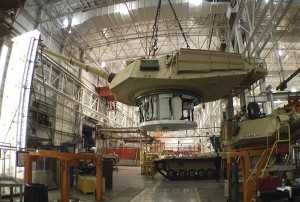Is The Successor To Manufacturing Jobs … Manufacturing?
Jim Tankersley
When the factory jobs disappear, what comes next?
That’s one of the most important economic questions America has confronted over the last decade-plus – where are the new industries, the new big ideas, the new jobs that should be springing up to replace the millions of manufacturing jobs lost to outsourcing and automation?
President Obama hasn’t had much success cultivating a big new sector to fill that vacuum. Now, his administration is trying something small. It’s a pilot program to encourage new industry development in cities that have shed factory jobs. And the new industry it seeks to develop is – yep – manufacturing.
Obama’s acting commerce secretary, Rebecca Blank, announced a small-bore program Wednesday that hopes to plant the seeds of new, advanced manufacturing activity in cities across the country. (If the goal sounds familiar, it is – Obama has been preaching the virtues of advanced manufacturing since he first ran for president, like so many other American politicians.)
This year, the program will offer grants to 20 to 25 communities, of about $200,000 each, to write “strategic plans” for their advanced manufacturing futures. The plans are supposed to say what each region is good at, what sort of product it might become a manufacturing hub for, and what federal help the region needs to make that happen. Blank calls that investing in “industrial ecosystems.”
Obama’s acting commerce secretary, Rebecca Blank, announced a small-bore program Wednesday that hopes to plant the seeds of new, advanced manufacturing activity in cities across the country. (If the goal sounds familiar, it is – Obama has been preaching the virtues of advanced manufacturing since he first ran for president, like so many other American politicians.)
This year, the program will offer grants to 20 to 25 communities, of about $200,000 each, to write “strategic plans” for their advanced manufacturing futures. The plans are supposed to say what each region is good at, what sort of product it might become a manufacturing hub for, and what federal help the region needs to make that happen. Blank calls that investing in “industrial ecosystems.”
“What we’re trying to do is give communities an incentive to change their thinking – to think, how do we attract new investment? – instead of coping with the loss of manufacturing,” she said. 2014 budget proposes giving five or six of those communities grants of about $20 million each, to help make their manufacturing infrastructure dreams come true.
It’s a relatively small amount, and Blank didn’t exactly raise expectations that it will lead to millions of new factory jobs, especially because manufacturing today is far less labor-intensive than it used to be.
But she hopes the proposals will set off a happy chain of activity in cities that have been beset by job losses, with new factory work driving more business activity (and job creation) to support it, along with new research that could lead to new industries.
“There are a lot of reasons to want more advanced manufacturing located in the United States beyond just job creation,” she said. “And the most important one is, advanced manufacturing is often on the cutting edge of research and development.”
Problem is, America is staring at a huge factory employment void – and needs a lot of job creation to fill it. University of Chicago economists recently found that manufacturing employment declines explain half of the increase in joblessness among men without college degrees in the past 10 years.
The dominant industry that replaced those jobs, in the mid-2000s, was housing. And that was driven by a bubble, which popped.
It’s a relatively small amount, and Blank didn’t exactly raise expectations that it will lead to millions of new factory jobs, especially because manufacturing today is far less labor-intensive than it used to be.
But she hopes the proposals will set off a happy chain of activity in cities that have been beset by job losses, with new factory work driving more business activity (and job creation) to support it, along with new research that could lead to new industries.
“There are a lot of reasons to want more advanced manufacturing located in the United States beyond just job creation,” she said. “And the most important one is, advanced manufacturing is often on the cutting edge of research and development.”
Problem is, America is staring at a huge factory employment void – and needs a lot of job creation to fill it. University of Chicago economists recently found that manufacturing employment declines explain half of the increase in joblessness among men without college degrees in the past 10 years.
The dominant industry that replaced those jobs, in the mid-2000s, was housing. And that was driven by a bubble, which popped.
SOURCE: Washington Post




Leave a Reply
Want to join the discussion?Feel free to contribute!